MONDAY'S SCRIPT TIP:
FLASHBACKS!
"Beware of Flashbacks, Dream Sequences, Visions - In narrative/dramatic material these tend to weaken the dramatic tension." - Alexander Mackendrick.
The problem is, a screenplay is like a shark - it has to be moving forward or it dies.
When you think about flashbacks in movies, what they do is move the story
forward... not fill in a bit of the past. The flashback in RESERVOIR DOGS is a
good example - Mr. Orange lies bleeding on the floor after the robbery goes
south... all around him the other robbers are pointing guns at each other and
accusing each other of informing the police - how did the police get there so
fast? Now we get Mr. Orange's flashback... he's an undercover cop. Now, we
may be going back in time, but Mr. Orange being an undercover cop
ESCALATES THE CONFLICT - they will kill him if they find out! He can't run,
he's been gutshot. So each bit of that flashback moves the story forward - we
are discovering more and more information that makes the present situation much worse. The
flashback moves the story forward - it isn't filling in a plot hole.
THE ACCOUNTANT got mixed reviews when it was released, and the reason behind those reviews? A big stinking pile
of exposition in Act Three of the movie which includes a lengthy flashback which does *nothing* to
escalate the conflict. It slows the movie down and kills the story... so that we can learn something
about a minor character (who could easily have been removed from the screenplay without damaging
the story). Now they are making a sequel - will it have the same story problems?

A completely forgotten movie, THE LIFE OF DAVID GALE is a textbook example of how NOT to use flashbacks.
An ambitious young reporter (Kate Winslet) is granted an interview with David
Gale (Kevin Spacey) a college professor and anti-death penalty activist who will
be executed at the end of the week. She will be given an interview on each of the
three last days of his life. Winslet and the interviews become excuses for flashbacks
of the events leading up to Gale's conviction. The first two flashbacks concern Gale's
life as a college professor... how he had an affair with a student that cost him his
job and his marriage. How he descended into alcoholism. How he couldn't keep even the
simplest of jobs. How he lost almost all of his friends and ended up a homeless drunk.
Okay - some of you may be wondering what this has to do with being on death row.
And that's a good question. The first problem is that these two flashbacks have nothing
to do with the story of a man on death row. Though these events provided an excuse for
why a jury might convict an intelligent, articulate man of murder when there is almost
no evidence - the flashbacks are boring and don't change the CURRENT story at all. At
the end of each flashback Gale is still on death row and we haven't learned anything
that will help his case. You'd think a guy with only three days to live would cut to
the chase! Because the flashbacks have no impact at all on present events, they are
pointless. They do not move the story forward, they just waste our time. We get to
know who David Gale is... but it's the life story of a college professor who screws
up his life. Not the most exciting story in the world. The first two thirds are like
sitting next to someone on a long airplane flight who insists on telling you about
their life in Topeka. Who cares?
The third flashback is the one with all of the story material. It's here where we
finally get to the murder and murder conviction. But even though Winslet gets to search
a house and find a video tape and race across town to try and stay the execution because
of the new evidence... the course of the story doesn't really change. The situation at
the end of the third flashback is EXACTLY THE SAME as the situation at the beginning of
the movie... making all of the flashbacks (and the movie itself) pointless. The flashbacks
don't change the story in any way - they don't give us any information that we couldn't
have guessed from the premise itself (many people have), and two of the flashbacks are just
time killers. A flashback needs to MOVE THE STORY FORWARD. A flashback needs to CHANGE the
present situation. These flashbacks just wasted our time.
Screenplays are told in present tense, so the stories told in screenplays usually take place in the
present - we see the story unfold as it is happening. Flashbacks are *not* about the past, they are about
the present time story. If they do not change the present time story, they are probably either plugging a
plot hole or some form of *Soap Opera Plot Twist*.
BACKSTORY?

Hey, but what if that flashback provides critical backstory? Well, where you place your backstory will
depend on where it moves the story forward - that may mean it's the opening scene! Or it may escalate the
conflict if you save that information and reveal it later.
If you have 7 different backstories that are really background material and
therefor need to be established before the story starts... you're in trouble. Let's
say your story is about 7 people who got screwed over by George Lucas as
he climbed his way to the top who decide to band together and kill him at the
premiere of the animated CLONE WARS movie. The problem is you need to
establish their motivations before the story starts, because the revelation that
Character #3 was the editor who said "R-2, D-2 would be a great name for a
robot!" doesn't escalate the conflict at all. So you have to start with these 7
stories... and each one will have to establish the relationship between the
character and Lucas so that the back-stabbing-on-the-way-to-the-top is a real
betrayal. That's not like the snippets we get in SORCERER that only need to
show us why these guys are broke in South America... each of these Lucas
things is it's own story. So the beginning of your script is going to be 7 stories
that need to be told before you can get on to the REAL story - killing George
Lucas. If each of this stories are cut down to 12 minutes - and that will be hard
to establish the bond of friendship and how it is betrayed in so little time - you
have 84 minutes before you can even get to the real story! If you're a frigging
genius and manage to get that story of friendship and betrayal down to 5
minutes each, you're still at 35 minutes of background material before the
story even starts! So a story like this is better suited to a form where you can
spend more time on the backstory - like a novel.

The problem with using a flashback only to reveal backstory is that it's just plugging a plot hole - it's
*script spackle*. If we need to know this piece of backstory in order to understand the present time story,
but that backstory has zero impact on the present time story - it's classic plot hole plugging. You need
to establish whatever backstory is required much earlier - Act 1 is the Set Up Act. Usually you want
to plant this information as early as possible and maybe even use the "rule of three" and re-establish the
information a second time somewhere in the story so that the audience just *knows it* without making a big
deal about it... and use whatever "reveal" as the third time that breaks the pattern. When you introduce
information - in a flashback right before it becomes important to the story it seems as if you are making
it up as you go along (and not in a good way) and the story seems false. You want the story to seem as
if it is unfolding naturally... not that the writer had to go back and add a piece so that it would make sense.
Things that happened in the past, before your story starts, are only important if they impact the current story -
*change* the current story. Using flashbacks as "soap opera twists" - where a bit of shocking information about
a character's past is revealed that *doesn't change the current story at all* is also a waste of time. Sure, it
may give the audience a jolt - but just like one of those plot twists on a soap opera ("He... was... my... boyfriend!")
they end up being silly and overblown because they don't have any real meaning. The story remains the same.
If that information changes the direction of the present time story, that's okay - but if it's just revealed information
that doesn't matter... it doesn't matter.
FLASHBACKS MOVE THE STORY FORWARD - THEY DON'T GO BACK & PLUG PLOT HOLES.
FRAMED!

A screenplay is told in present tense and it is about things that are happening *now*... but there's a great little
"cheat" called a "framing device" that is often used in films that may start a little slow. A couple of great
examples are DOUBLE INDEMINITY and SUNSET BLVD - both begin at the end and then "flashback" to the beginning.
The thing about this technique is that after that initial scene, the rest of the film happens in a form of present time...
where the story's conflict is. In DOUBLE INDEMNITY the protagonist Walter Neff is bleeding to death and clicks on his
dictaphone to record his confession... and then the whole rest of the movie is what brought him to this point in time.
So, even though it's technically a flashback, it's the story unfolding in one time period. No flashbacks within that
flashback. SUNSET BLVD opens with the protagonist *dead* - floating in a swimming pool while paparazzi take his picture...
and then we flashback to how he came to be dead. But once we have flashed back, we stay back. How these stories work is
that we eventually go through the story until we get to that point where we started (the end) and then we get a little
smidgen or story (or not in the case of SUNSET BLVD). These aren't really flashbacks, because they tell the whole story.
Just to throw in another example, MURDER MY SWEET opens with Marlowe being interrogated by the police - eyes bandaged
and blind. Lots of people have been murdered and the police think he may be responsible. So, as Marlowe "confesses",
we go back to the beginning of the story and it is told in that version of the "present" until we come to the police
station in that version of "present time" - our story has gone full circle to the beginning! Then we get that minute
or two "tag" at the end. Like the two Billy Wilder films, this is only technically a flashback, since only 1% of the
story takes place in the present. The other 99% takes place in the same time period as the story unfolds just like any
other story would. Usually this is done when a story starts slow, to clue in the audience that there are exciting
things to come, and/or build a mystery (how did Marlowe get blinded?). This is a great technique for the toolbox.

I suspect this may be the idea behind the flashbacks in DAVID GALE, except the problem they ran into was that *nothing
happens* in the first two flashbacks - the first two thirds of the film - so they had to return to the Death Row element
to remind us why we should care. But the problem is that nothing happens for two thirds of the danged film, and no
amount of artificial flashback stuff is going to make it more interesting. This is a *story problem* that can not be
resolved with the "framing" technique. If you look at the two Billy Wilder movies and MURDER MY SWEET, once we get
past the initial "frame" opening the story really gets going - lots of exciting things happen. The problem with
DAVID GALE is that once we flashback, nothing happens. Nothing happens for two thirds of the film! It's all kind
of boring backstory stuff. Compare this to MURDER MY SWEET where there's a gun out and a threat the moment we
"flash back"... or DOUBLE INDEMINTY where we go directly to Neff and Phyllis meeting and flirting and taking about
a life insurance policy for that husband she doesn't love anymore... or SUNSET BLVD which has our protagonist out
running repo guys who are after his car because he's a flat broke screenwriter. And even after we have "flash backed"
into the story, there's no shortage of conflict and excitement. The problem with DAVID GALE is that nothing happens
until the last third (or less) or the story, so those two initial flashbacks are just time killers. This is a
story with serious structure issues, and those can not be solved with a framing device.

When you use a framing device, the conflict alive and active in that "past" - once we go back and become involved
in the story we stay there and deal with that conflict until it is resolved. The issue with DAVID GALE is that even
when we went back to the "past" there was no conflict... the only conflict in the story is that he's on Death Row.
So the flashback is just expositional, and not only doesn't change the present time conflict... there's no conflict
in the past either! The only conflict in the story is the execution - and that's a dead conflict. It can not be changed.
You want to find a conflict that is *active and alive* and not dead. Any time you have a conflict where the
resolution is set in stone, it's dead, Jim. Had each of the flashbacks in DAVID GALE been filled with conflict
and twists and *things happening*, the film would have worked. Instead, every time we came out of a flashback...
we were in the exact same place and not a thing had changed.
And the story seems stalled out and dead.
YOUR SCRIPT CHECKLIST:
1) What is the impact of your flashback on the present time story?
2) Does the flashback escalate the conflict, or just give information?
A script is like a shark - the story must always be moving forward... even when it's a flashback.
BRAND NEW!
How Do I do That?

101 SCREENWRITING ANSWERS Blue Book!
New to screenwriting? You probably have questions! How do I get an Agent? How do I write a phone conversation? Do I need a Mentor? What’s does VO and OC and OS mean? What is proper screenplay format? Should I use a pen name? Do I need to movie to Hollywood? What’s the difference between a Producer and a Production Manager, and which should I sell my script to? How do I write a Text Message? Should I Copyright or WGA register my script? Can I Direct or Star? How do I write an Improvised scene? Overcoming Writer’s Block? How do I write a Sex Scene? And many many more! This book has the answers to the 101 Most Asked Questions from new screenwriters! Everything you need to know to begin writing your screenplay!
All of the answers you need to know, from a working professional screenwriter with 20 produced films and a new movie made for a major streaming service in 2023!
Only $4.99
NEWEST AND BLUEST!
Want To Look Like An Expert?

RESEARCH & WORLD BUILDING Blue Book!
Does this gun fire 6 shots or only 5? In all of the excitement of writing your action scene, you might not have done the research... and your hero could be out of ammo! Whether you are writing a novel or screenplay, you can save your hero, and your story, by doing a little research first! This book looks at Why you should research, Whether you should research First or Later, PLUS the importance of World Building in Science Fiction, Fantasy... and the worlds you explore in every other genre. Movies like JOHN WICK and THE GODFATHER take place in their own unique worlds... and writers must create them! YOU are the technical advisor on your Screenplay or Novel.
Using movie examples like TOP GUN, HUNT FOR RED OCTOBER, BLUE CRUSH, ADVENTURE LAND, several of my produced films, JOHN WICK, the novels of Donald E. Westlake and Thomas B. Dewey, SPY KIDS, the LORD OF THE RINGS movies, SOYLENT GREEN (which takes place in the far off future of 2022), and many others we will look at researching stories and creating worlds. The 8 Types Of Research, the 10 Types Of Information To Look For, 12 Important Elements Of World Building. Plus chapters on How To Rob A Bank and Commit Murder And Get Away With It for those of you interested in crime fiction, and Researching The Future for those writing science fiction, and Levels Of Reality if you are writing about a version of the real world.
No matter what you are writing, this book will help you find the facts... or make them up in a convincing way!
Only $4.99
NO KINDLE REQUIRED! Get the *free* app (any device, except your Mr. Coffee) on the order page on Amazon!
FINISHED WRITING?
All About Rewrites!
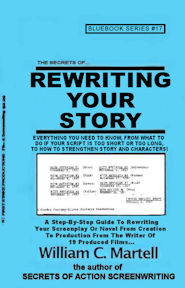
REWRITES Blue Book!
Rewriting In Waves?
When You Finish Your Screenplay Or Novel...
The Rewrites Begin!
The end is just the beginning! You’ve finished your story, but now the rewriting begins! This 405 page book shows you how to rewrite your screenplay or novel to perfection. Everything from Character Consistency to Shoeboxing to How To Give And Receive Notes to 15 Solutions If Your Script’s Too Long! and 15 Solutions If Your Script’s Too Short! to Finding The Cause Of A Story Problem to Good Notes Vs. Bad Notes to Finding Beta Readers to Avoiding Predictability to Learning To Be Objective About Your Work to Script Killer Notes and Notes From Idiots to Production Rewrites and What The Page Colors Mean? and a Complete Rewrite Checklist! The complete book on Rewriting Your Story!
Only $4.99
NEW ISH!
All About Endings!
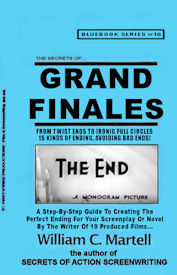
GRAND FINALES Blue Book!
The Perfect Ending For Your Story!
The First Ten Pages Of Your Screenplay Are Critical,
But What About The Last 10 Pages?
Creating the perfect ending to your story! This 100,000 word book shows you how to end your story with a bang, rather than a whimper. Everything from Resolution Order to Act Three Tools to Happy or Sad Endings? to How The Beginning Of Your Story Has Clues To The Ending (in case you were having trouble figuring out how the story should end) to Falling Action to How To Avoid Bad Endings to Writing The Perfect Twist Ending to Setting Up Sequels & Series to Emotional Resolutions to How To Write Post Credit Sequences to Avoiding Deus Ex Machinas, to 20 Different Types Of Ends (and how to write them) and much more! Everything about endings for your screenplay or novel!
Only: $4.99
NO KINDLE REQUIRED! Get the *free* app (any device, except your Mr. Coffee) on the order page on Amazon!
SHRINKING IT DOWN
All About LOGLINES, TREATMENTS, and PITCHING!

LOGLINES, TREATMENTS, and PITCHING! Blue Book!
Distilling Your Screenplay!
Loglines, Treatments, Pitching, Look Books, Pitch Decks, One Pagers, Rip-O-Matics?
You have written a brilliant 110 page screenplay, but how do you get anyone to read it? You need to distill it down into some form of verbal moonshine or story rocket fuel that will ignite that bored development executive or manager or agent and get them to request your screenplay. But how do you shrink those 110 pages into a 25 word logline or a 2 minute elevator pitch or a one page synopsis or a short paragraph? This 100,000 word book shows you how! Everything you need to know! From common logline mistakes (and how to solve them) to how your pitch can reveal story problems to the 4 types of pitches!
272 Pages - ONLY $4.99!
NEW in 2020!
Making Your Own Movie?
WRITE IT: FILM IT BOOK!

Making Your Own Movie?
Writing An Indie Film?
Writing A Low Budget Genre Script To Sell?
Writing A Made For TV Holiday Movie?
You will be writing for BUDGET. On a standard spec screenplay, you don’t have to think about budget, but these types of screenplays writing with budget in mind is critical!
If you are making your own movie, budget, is even more important - and you need to think about budget *before* you write your screenplay... or you will end up with a script that you can’t afford to make (or is a struggle to make). Everyone is making their own films these days, and even if you have done it before there are lots of great techniques in this book to get more money on screen - for less money! You can make a film that looks like it cost millions for pocket change.
344 Pages - ONLY: $7.99!
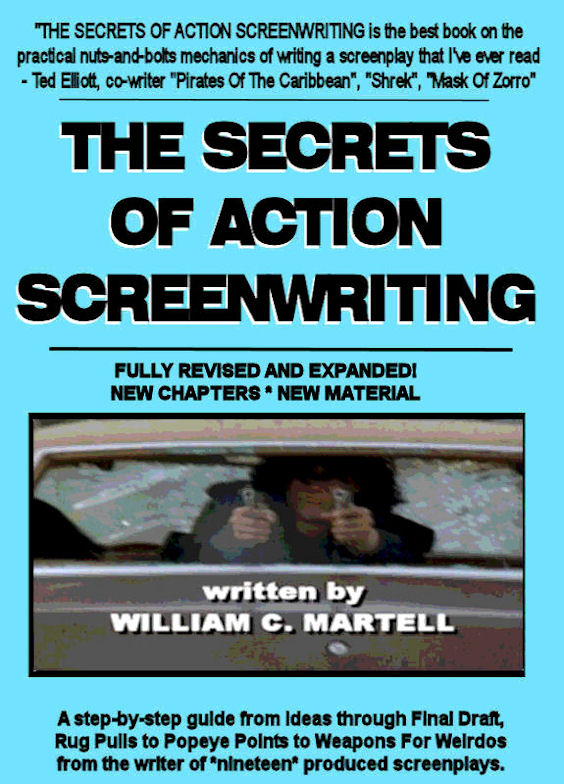
THE BOOK THAT STARTED IT ALL!
*** THE SECRETS OF ACTION SCREENWRITING *** - For Kindle!
*** THE SECRETS OF ACTION SCREENWRITING *** - For Nook!
Why pay $510 for a used version of the 240 page 2000 version that used to retail for $21.95? (check it out!) when
you can get the NEW EXPANDED VERSION - over 500 pages - for just $9.99? New chapters, New examples, New techniques!
"SECRETS OF ACTION SCREENWRITING is the
best book on the practical nuts-and-bolts mechanics of writing a screenplay I've ever read."
- Ted Elliott, co-writer of MASK OF ZORRO, SHREK, PIRATES OF THE CARIBBEAN and the sequels (with Terry Rossio). (ie; 4 of the top 20 Box Office Hits Of ALL TIME.)
Only $9.99 - and no postage!
BRAND NEW!
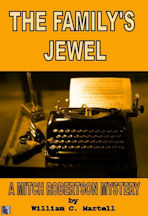
***
MITCH ROBERTSON #2: THE FAMILY'S JEWEL *** - For Kindle!
"The Presidential Suite of the Hollywood Hoover Hotel looked like a bloody battlefield: bodies everywhere, furniture broken, red liquid dripping from the walls, dead soldiers littering the elegant Berber rug as clouds of smoke overhead bounced between two air conditioning vents.
Mitch Robertson stepped over the body of an ex-child star turned sex tape star turned pop star and entered the room, spotted a gun on the floor and picked it up... careful not to spill his coffee with three pumps of mocha syrup from Penny’s Coffee Shop. That coffee was gold, the only thing keeping him going in this dazed state of wakefulness. The gun felt light. Holding it, he saw the silhouette of an 80s action star sitting sideways on a tipped over chair. Motionless. Was he dead? Mitch was still hung over from the Awards Party the night before, and wondered whether this was all some sort of crazy nightmare that he would wake up from... but when he tripped over the brown legs of a bottomless Superhero, flaccid junk encased in a condom but still wearing his mask, and hit the edge of the sofa, gun skittering and coffee spilling, he realized that it was all very real. What the hell had happened here?"
Short Novel. Only 99 cents! - and no postage!
Tips FAQ

My New Script Secrets Newsletter!

THE BLUE BOOKS!
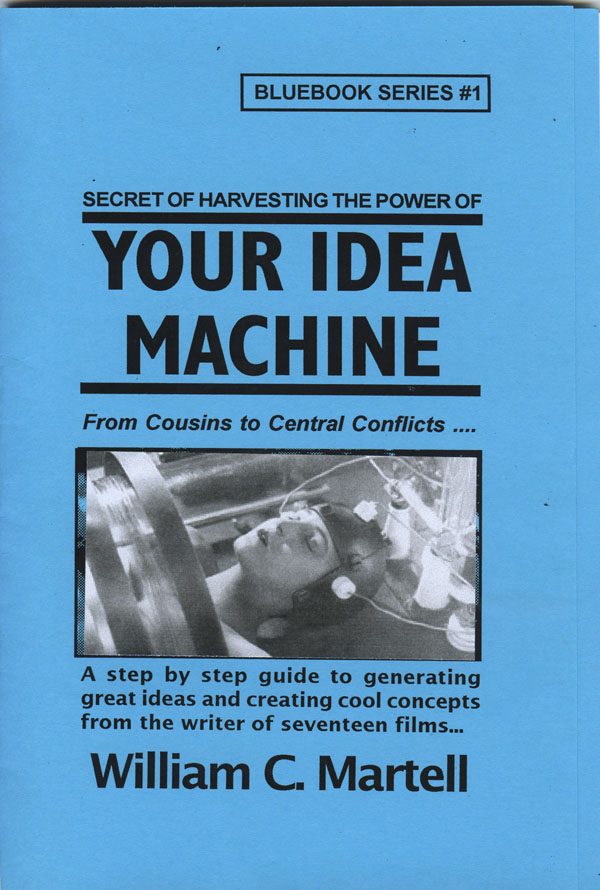
FIND A GREAT IDEA!
*** YOUR IDEA MACHINE *** - For Kindle!
****
Expanded version with more ways to find great ideas! Your screenplay is going to begin with an idea. There are good ideas and bad ideas and commercial ideas and personal ideas. But where do you find ideas in the first place? This handbook explores different methods for finding or generating ideas, and combining those ideas into concepts that sell. The Idea Bank, Fifteen Places To Find Ideas, Good Ideas And Bad Ideas, Ideas From Locations And Elements, Keeping Track Of Your Ideas, Idea Theft - What Can You Do? Weird Ways To Connect Ideas, Combing Ideas To Create Concepts, High Concepts - What Are They? Creating The Killer Concept, Substitution - Lion Tamers & Hitmen, Creating Blockbuster Concepts, Magnification And The Matrix, Conflict Within Concept, Concepts With Visual Conflict, Avoiding Episodic Concepts, much more! Print version is 48 pages, Kindle version is over 175 pages!
Only $4.99 - and no postage!
FIGURE OUT YOUR STORY!
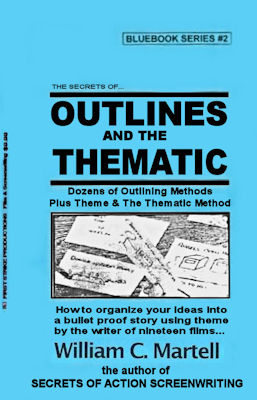
OUTLINES & THE THEMATIC Blue Book.
ARE YOUR SCENES IN THE RIGHT ORDER?
AND ARE THEY THE RIGHT SCENES?
Your story is like a road trip... but where are you going? What's the best route to get there? What are the best sights to see along the way? Just as you plan a vacation instead of just jump in the car and start driving, it's a good idea to plan your story. An artist does sketches before breaking out the oils, so why shouldn't a writer do the same? This Blue Book looks at various outlining methods used by professional screenwriters like Wesley Strick, Paul Schrader, John August, and others... as well as a guest chapter on novel outlines. Plus a whole section on the Thematic Method of generating scenes and characters and other elements that will be part of your outline. The three stages of writing are: Pre-writing, Writing, and Rewriting... this book looks at that first stage and how to use it to improve your screenplays and novels.
Only $4.99 - and no postage!
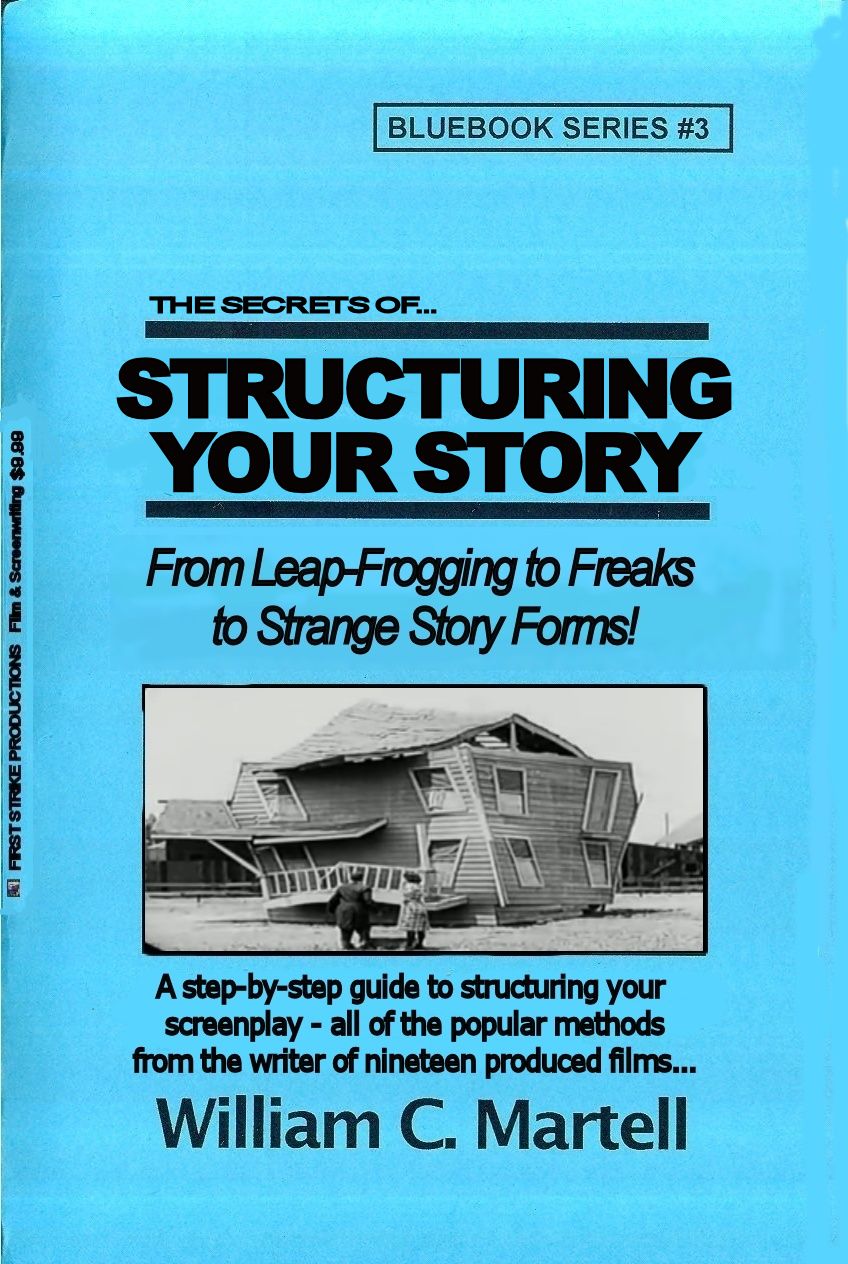
GOT STRUCTURE?!
*** STRUCTURING YOUR STORY *** - For Kindle!
William Goldman says the most important single element of any screenplay is structure. It’s the skeleton under the flesh and blood of your story. Without it, you have a spineless, formless, mess... a slug! How do you make sure your structure is strong enough to support your story? How do you prevent your story from becoming a slug? This Blue Book explores different types of popular structures from the basic three act structure to more obscure methods like leap-frogging. We also look at structure as a verb as well as a noun, and techniques for structuring your story for maximum emotional impact. Most of the other books just look at *structure* and ignore the art of *structuring* your story. Techniques to make your story a page turner... instead of a slug!
Only $4.99 - and no postage!
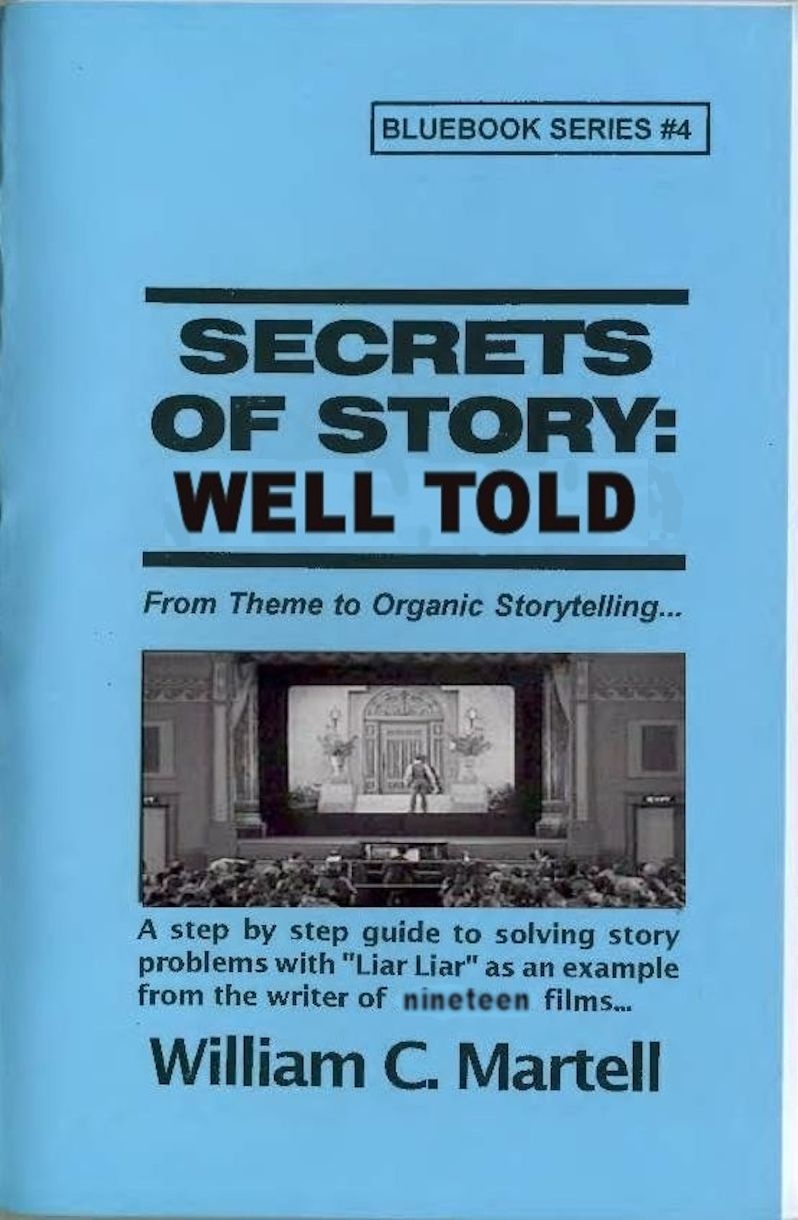
STORY: WELL TOLD!
*** STORY: WELL TOLD *** - For Kindle!
This book takes you step-by-step through the construction of a story... and how to tell a story well, why Story always starts with character... but ISN'T character, Breaking Your Story, Irony, Planting Information, Evolving Story, Leaving No Dramatic Stone Unturned, The Three Greek Unities, The Importance Of Stakes, The Thematic Method, and how to create personal stories with blockbuster potential. Ready to tell a story?
Print version was 48 pages, Kindle version is over 85,000 words - 251 pages!
Only $4.99 - and no postage!

START STRONG!
*** HOOK 'EM IN TEN *** - For Kindle!
Your story doesn't get a second chance to make a great first impression, and this book shows you a
bunch of techniques on how to do that. From the 12 Basic Ways To Begin Your Story, to the 3 Stars Of
Your First Scene (at least one must be present) to World Building, Title Crawls, Backstory, Starting
Late, Teasers and Pre Title Sequences, Establishing Theme & Motifs (using GODFATHER PART 2), Five Critical
Elements, Setting Up The Rest Of The Story (with GODFATHER), and much more! With hundreds of examples
ranging from Oscar winners to classic films like CASABLANCA to some of my produced films (because
I know exactly why I wrote the scripts that way). Biggest Blue Book yet!
Print version was 48 pages, Kindle version is over 100,000 words - 312 pages!
Only $4.99 - and no postage!
NO KINDLE REQUIRED! Get the *free* app (any device, except your Mr. Coffee) on the order page on Amazon!
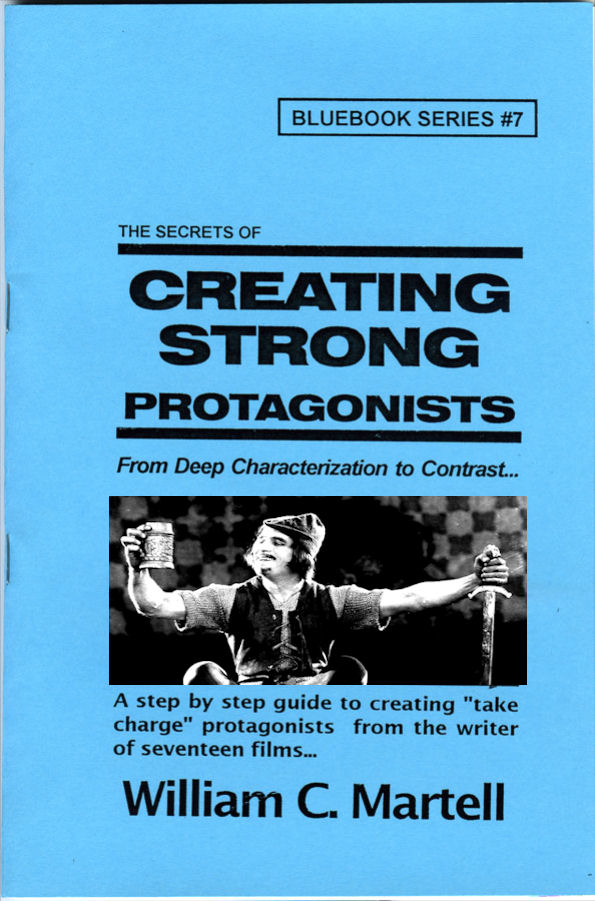
MOVIES ARE CHARACTERS!
*** CREATING STRONG PROTAGONISTS *** - For Kindle!
*** CREATING STRONG PROTAGONISTS *** - For Nook!
Expanded version with more ways to create interesting protagonists! A step-by-step guide to creating "take charge" protagonists. Screenplays are about characters in conflict... characters in emotional turmoil... Strong three dimensional protagonists who can find solutions to their problems in 110 pages. But how do you create characters like this? How do you turn words into flesh and blood? Character issues, Knowing Who Is The Boss, Tapping into YOUR fears, The Naked Character, Pulp Friction, Man With A Plan, Character Arcs, Avoiding Cliche People, Deep Characterization, Problem Protagonists, 12 Ways To Create Likable Protagonists (even if they are criminals), Active vs. Reactive, The Third Dimension In Character, Relationships, Ensemble Scripts, and much, much more. Print version is 48 pages, Kindle version is once again around 205 pages!
ONLY $4.99 - and no postage!
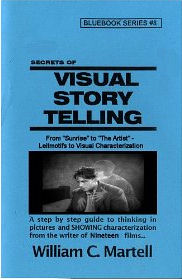
I WRITE PICTURES!
*** VISUAL STORYTELLING *** - For Kindle! (exclusive)
Show Don't Tell - but *how* do you do that? Here are techniques to tell stories visually! Using Oscar Winning Films and Oscar Nominated Films as our primary examples: from the first Best Picture Winner "Sunrise" (1927) to the Oscar Nominated "The Artist" (which takes place in 1927) with stops along the way Pixar's "Up" and Best Original Screenplay Winner "Breaking Away" (a small indie style drama - told visually) as well as "Witness" and other Oscar Winners as examples... plus RISE OF THE PLANET OF THE APES. Print version is 48 pages, Kindle version is over 200 pages!
ONLY $4.99 - and no postage!
DESCRIPTION & VOICE Blue Book!
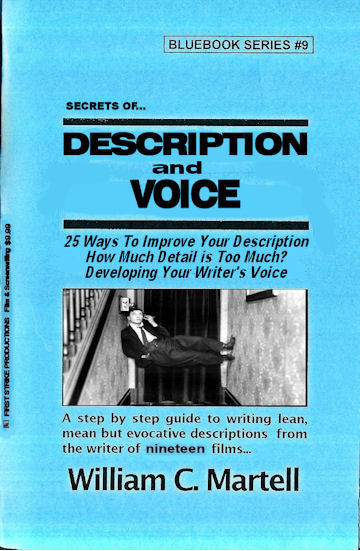
DESCRIPTION & VOICE Blue Book.
IS HALF OF YOUR STORY IN TROUBLE?
Most screenplays are about a 50/50 split between dialogue and description - which means your description is just as important as your dialogue. It just gets less press because the audience never sees it, the same reason why screenwriters get less press than movie stars. But your story will never get to the audience until readers and development executives read your script... so it is a very important factor. Until the movie is made the screenplay is the movie and must be just as exciting as the movie. So how do you make your screenplay exciting to read? Description is important in a novel as well, and the “audience” does read it... how do we write riveting description?
Only $4.99 and no postage!

PRO DIALOGUE TECHNIQUES!
*** DIALOGUE SECRETS *** - For Kindle!
***
Expanded version with more ways to create interesting dialogue! How to remove bad dialogue (and what *is* bad dialogue), First Hand Dialogue, Awful Exposition, Realism, 50 Professional Dialogue Techniques you can use *today*, Subtext, Subtitles, Humor, Sizzling Banter, *Anti-Dialogue*, Speeches, and more. Tools you can use to make your dialogue sizzle! Special sections that use dialogue examples from movies as diverse as "Bringing Up Baby", "Psycho", "Double Indemnity", "Notorious", the Oscar nominated "You Can Count On Me", "His Girl Friday", and many more! Print version is 48 pages, Kindle version is over 175 pages!
Only $4.99 - and no postage!

WHAT IS A SCENE?
*** SCENE SECRETS *** - For Kindle!
***
What is a scene and how many you will need? The difference between scenes and sluglines. Put your scenes on trial for their lives! Using "Jaws" we'll look at beats within a scene. Scene DNA. Creating set pieces and high concept scenes. A famous director talks about creating memorable scenes. 12 ways to create new scenes. Creating unexpected scenes. Use dramatic tension to supercharge your scenes. Plants and payoffs in scenes. Plus transitions and buttons and the all important "flow"... and more! Over 65,000 words! Print version was 48 pages, Kindle version is around 210 pages!
Only $4.99 - and no postage!
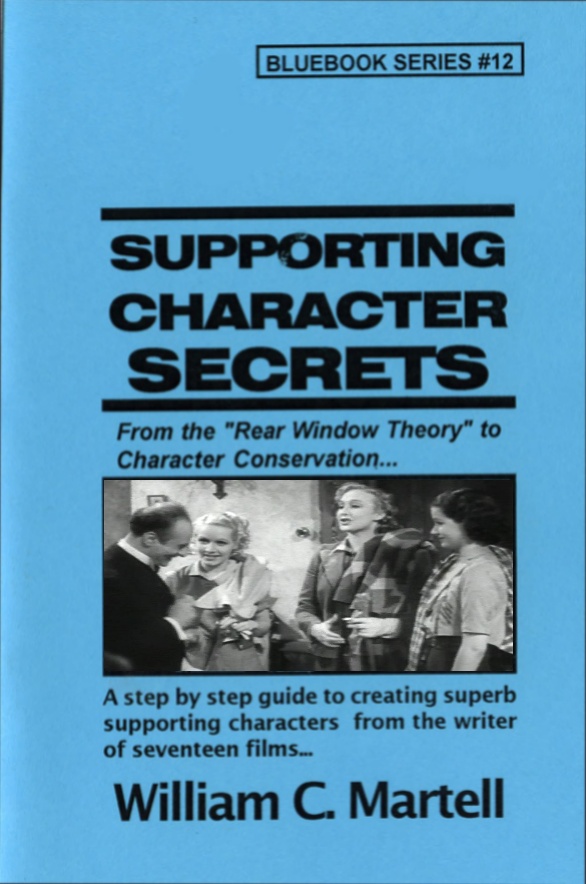
SUBPLOTS?
*** SUPPORTING CHARACTER SECRETS *** - For Kindle! (Exclusive)
Expanded version with more techniques to flesh out your Supporting Characters and make them individuals. Using the hit movie BRIDESMAIDS as well as other comedies like THE HANGOVER and TED and HIGH FIDELITY and
40 YEAR OLD VIRGIN and many other examples we look at ways to make your Supporting Characters come alive on the page.
Print version was 48 pages, Kindle version is around 170 pages!
ONLY $4.99 - and no postage!
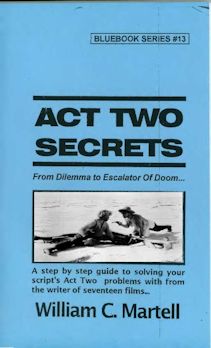
ACT TWO SOLUTIONS!
*** ACT TWO SECRETS *** - For Kindle!
Expanded version with more techniques to help you through the desert of Act Two! Subjects Include: What Is Act Two? Inside Moves, The 2 Ps: Purpose & Pacing, The 4Ds: Dilemma, Denial, Drama and Decision, Momentum, the Two Act Twos, Subplot Prisms, Deadlines, Drive, Levels Of Conflict, Escalation, When Act Two Begins and When Act Two Ends, Scene Order, Bite Sized Pieces, Common Act Two Issues, Plot Devices For Act Two, and dozens of others. Over 67,000 words (that’s well over 200 pages) of tools and techniques to get you through the desert of Act Two alive!
Print version was 48 pages, Kindle version is well over 200 pages!
ONLY $4.99 - and no postage!
READY TO BREAK IN?
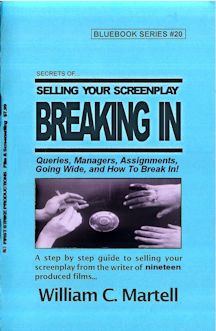
THE BUISINESS SIDE
*** BREAKING IN BLUE BOOK *** - For Kindle!
Should really be called the BUSINESS BLUE BOOK because it covers almost everything you will need to
know for your screenwriting career: from thinking like a producer and learning to speak their language,
to query letters and finding a manager or agent, to making connections (at home and in Hollywood) and
networking, to the different kinds of meetings you are will have at Studios, to the difference between
a producer and a studio, to landing an assignment at that meeting and what is required of you when you
are working under contract, to contracts and options and lawyers and... when to run from a deal!
Information you can use *now* to move your career forward! It's all here in the Biggest Blue Book yet!
Print version was 48 pages, Kindle version is over 400 pages!
$4.99 - and no postage!

STORY IN ACTION SERIES!

THE MISSION IMPOSSIBLE MOVIES
NEW: Updates On Films 7 & 8 Casting!
All Six Movies analyzed! All of the mission tapes, all of the “that’s impossible!” set pieces and stunts, the cons and capers - and how these scenes work, the twists and double crosses, the tension and suspense (and how to generate it), the concept of each film as a stand alone with a different director calling the shots (broken in the sixth film), the gadgets, the masks, the stories, the co-stars and team members (one team member has been in every film), the stunts Tom Cruise actually did (and the ones he didn’t), and so much more! Over 120,000 words of fun info!
THE MISSION IMPOSSIBLE MOVIES - 347 Pages - Only $3.99 !

BRAND NEW!
*** THE BOURNE MOVIES
NEW: Updates on TREADSTONE TV show!
All five "Bourne" movies (including "Legacy" and it's potential sequels) - what are the techniques used to keep the characters and scenes exciting and involving? Reinventing the thriller genre...
or following the "formula"? Five films - each with an interesting experiment! A detailed analysis of each
of the films, the way these thrillers work... as well as a complete list of box office and critical
statistics for each film. This book is great for writers, directors, and just fans of the series.
Only $3.99 - and no postage!
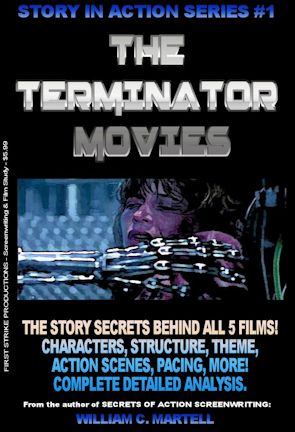
Over 240 pages!
*** THE TERMINATOR MOVIES *** - For Kindle!
He's back! The release of "Terminator: Dark Fate" is set to begin a new trilogy in
the Terminator story... 35 years after the first film was released. What draws us to these films about
a cybernetic organism from the future sent back in time? Why is there a new proposed trilogy every few
years? This book looks at all five Terminator movies from a story standpoint - what makes them work
(or not)? What are the techniques used to keep the characters and scenes exciting and involving? How
about those secret story details you may not have noticed? Containing a detailed analysis of each of
the five films so far, this book delves into the way these stories work... as well as a complete list of
box office and critical statistics for each film. This book is great for writers, directors, and just
fans of the series.
ONLY $3.99 - and no postage!
HITCHCOCK FOR WRITERS!
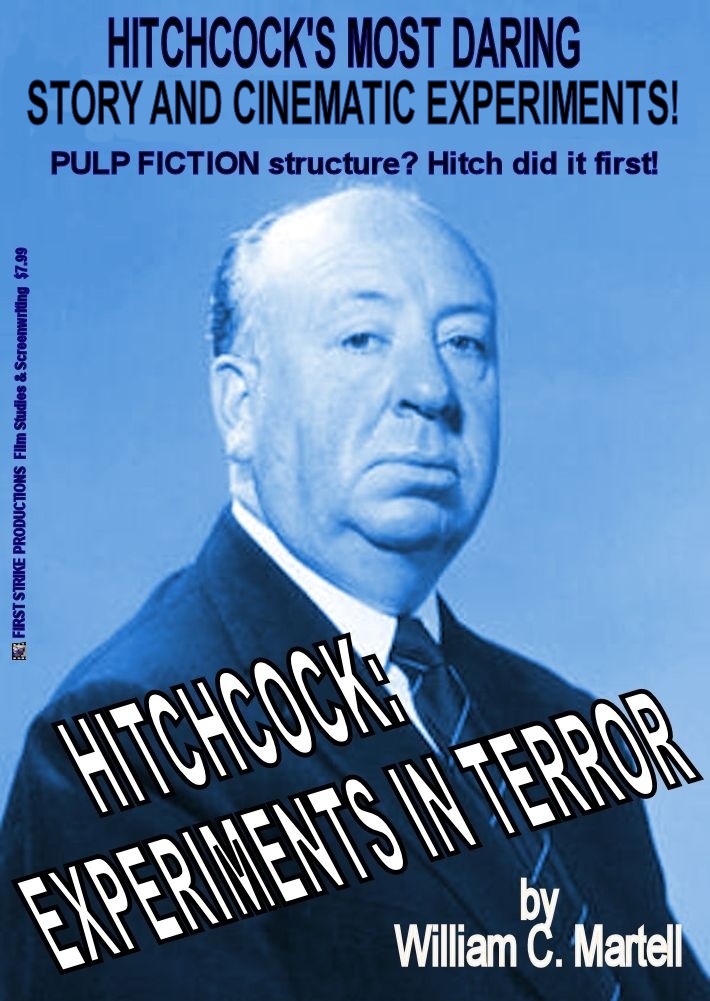
Strange Structures!
*** HITCHCOCK: EXPERIMENTS IN TERROR! *** - For Kindle!
***
Contained Thrillers like "Buried"? Serial Protagonists like "Place Beyond The Pines"? Multiple Connecting Stories like "Pulp Fiction"? Same Story Multiple Times like "Run, Lola, Run"?
HITCHCOCK DID IT FIRST!
This book focuses on 18 of Hitchcock's 52 films with wild cinema and story experiments which paved the way for modern films. Almost one hundred different experiments that you may think are recent cinema or story inventions... but some date back to Hitchcock's *silent* films! We'll examine these experiments and how they work. Great for film makers, screenwriters, film fans, producers and directors.
Only $5.99 - and no postage!
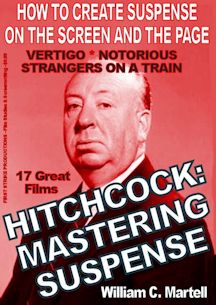
LEARN SUSPENSE FROM THE MASTER!
*** HITCHCOCK: MASTERING SUSPENSE *** - For Kindle!
Alfred Hitchcock, who directed 52 movies, was known as the *Master Of Suspense*; but what exactly is suspense and how can *we* master it? How does suspense work? How can *we* create “Hitchcockian” suspense scenes in our screenplays, novels, stories and films?
This book uses seventeen of Hitchcock’s films to show the difference between suspense and surprise, how to use “focus objects” to create suspense, the 20 iconic suspense scenes and situations, how plot twists work, using secrets for suspense, how to use Dread (the cousin of suspense) in horror stories, and dozens of other amazing storytelling lessons. From classics like “Strangers On A Train” and “The Birds” and “Vertigo” and “To Catch A Thief” to older films from the British period like “The 39 Steps” and “The Man Who Knew Too Much” to his hits from the silent era like “The Lodger” (about Jack The Ripper), we’ll look at all of the techniques to create suspense!
Only $5.99
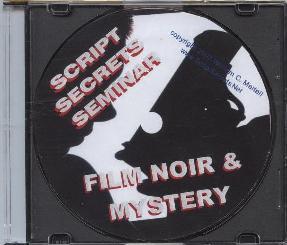
AUDIO CLASS!
NOIR & MYSTERY80 minute MP3 packed with information on writing Film Noir and Mystery scripts. Using examples from CHINATOWN to OUT OF THE PAST to DOUBLE INDEMNITY you'll learn how to create stories in this dark, twisted genre. How to plant clues, red herrings, suspects, victims, spider women, fallen heroes, the funhouse mirror world of noir supporting characters... and the origins of Film Noir in literature Noir dialogue and how noir endings are different than any other genre. All of the critical elements necessary to write in this critically popular genre.
The Noir & Mystery Class is only $15 (plus $5 S&H). First 20 on Limited Black Disk!
PAMDEMIC SALE! $5 OFF!
IDEAS AND CREATIVITY - 80 minute MP3 packed with information. Tools to find ideas that are both personal *and* commercial. Hollywood wants scripts with High Concept stories... but not stupid scripts. Developing *intelligent* high concept ideas. How to turn your personal story into a blockbuster - or find your personal story in a high concept idea. Brainstorming and being creative. Ideas and Creativity is $10.00 (plus $5 S&H)
WRITING INDIES - Writing an Indie film? This class covers everything you need to know - from Central Locations to Confined Cameos. Using examples from SWINGERS, THE COOLER, STATION AGENT and others, this 80 minute MP3 is packed with information. How Indoe films challenge the audience (while mainstream films reassure the audience). Structures, using BOYS DON'T CRY, RUN LOLA RUN, HILARY & JACKIE, and others as example. Writing for a budget, writing for non-actors, getting the most production value out of your budget. Writing Indies is $10.00 (plus $5 S&H)
WRITING HORROR - The essentials of a horror screenplay - what do ROSEMARY'S BABY, NIGHT OF THE LIVING DEAD, THE EXORCIST, BRIDE OF FRANKENSTEIN, THE OTHERS and OPEN WATER have in common? This class will tell you! All of the critical elements necessary to write a script that scares the pants off the audience. Writing Horror is $10.00 (plus $5 S&H).
Click here for more information on CLASS MP3s!

Use your creative energy to focus on the content; let Final Draft take care of the style. Final Draft is the number-one selling application specifically designed for writing movie scripts, television episodics and stage plays. Its ease-of-use and time-saving features have attracted writers for almost two decades positioning Final Draft as the Professional Screenwriters Choice. Final Draft power users include Academy, Emmy and BAFTA award winning writers like Oliver Stone, Tom Hanks, Alan Ball, J.J. Abrams, James Cameron and more.
* * * Buy It!
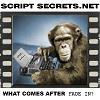
|

